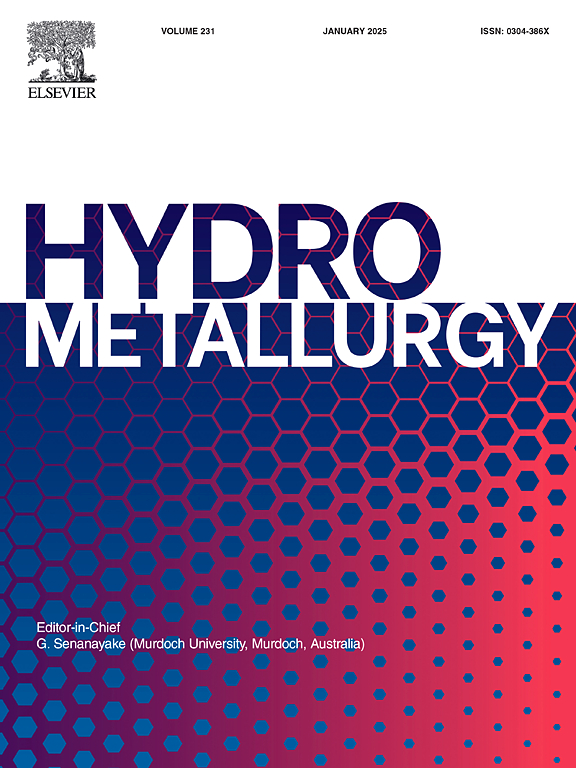The effect of persistent exposure to thiocyanate and the impact on inhibition of ferrous iron oxidation in an industrial strain of Acidiplasma cupricumulans
IF 4.8
2区 材料科学
Q1 METALLURGY & METALLURGICAL ENGINEERING
引用次数: 0
Abstract
Acidiplasma cupricumulans is recorded as an acidophilic chemomixotrophic iron-oxidising archaeal species that is prevalent within the mineral biooxidation community. The archaeal strain was persistently exposed to 1 mg/L of SCN−, a toxic anion present in low concentrations in remediated cyanidation tailings wastewater from gold recovery plants, to potentially facilitate adaptation. Adaptation to a concentration of 1 mg/L SCN− was induced. The performance data of the thiocyanate-adapted strain was compared with that of the control strain to characterise the evolutionary change in microbial activity. Adaptation to SCN− altered microbial growth, producing an elevated which possibly denoted an upregulation within the central carbon metabolism. Furthermore, adaptation suppressed the rate of Fe2+ oxidation. As such, the Fe2+ oxidation rate expression developed previously for Ap. cupricumulans was not suitable and required modification of the kinetic constant () to account for the observed reduction in substrate affinity. The updated was ∼3 times larger which aligned with the suspected bioenergetic burden. In addition, the inhibition kinetics of the adapted strain were evaluated across a SCN− range of 0–3.0 mg/L to quantify changes in microbial resilience. The inhibition mechanism remained unchanged, with Fe2+ oxidation activity non-competitively inhibited by SCN− in the solution matrix. However, adaptation increased the sensitivity of Ap. cupricumulans SCN− and resulted in an inhibition constant () ∼2 times smaller relative to the control strain. The presented inhibition model predicted experimental data well, particularly at concentrations between 1 and 1.5 mg/L SCN−; at concentrations above 1.5 mg/L SCN the deviation between repeat data sets was exacerbated and reflected an elevated degree of sensitivity to culture conditions and the potential impact of multiple stressors. Adaptation to 1 mg/L SCN− did not confer any beneficial alteration within the cell and highlighted that the accumulation of SCN− within biooxidation circuits should be carefully monitored to maintain the desired structure of the microbial community, and therein process efficiency.
硫氰酸盐持续暴露对铜酸浆工业菌株亚铁氧化抑制的影响
cupricumulans是一种在矿物生物氧化群落中普遍存在的嗜酸性化学共生氧化铁古菌。该古细菌菌株持续暴露于1 mg/L的SCN−中,SCN−是一种有毒阴离子,存在于金回收厂修复的氰化尾矿废水中,浓度较低,可能促进其适应。诱导对浓度为1mg /L的SCN -的适应。将适应硫氰酸盐的菌株与对照菌株的性能数据进行比较,以表征微生物活性的进化变化。对SCN−的适应改变了微生物的生长,产生了升高的Yxs,这可能表明了中央碳代谢的上调。此外,适应性抑制了Fe2+的氧化速率。因此,先前建立的Ap. cupricumulans的Fe2+氧化速率表达不合适,需要修改动力学常数(KFe2+)来解释观察到的底物亲和力降低。更新后的KFe2+大了约3倍,这与怀疑的生物能负荷一致。此外,在0-3.0 mg/L的SCN范围内评估了适应菌株的抑制动力学,以量化微生物恢复力的变化。抑制机制保持不变,溶液基质中SCN−对Fe2+的氧化活性无竞争性抑制。然而,适应性增加了app . cupricumulans SCN -的敏感性,导致抑制常数(Ki)相对于对照菌株小2倍。该模型能很好地预测实验数据,特别是在1 ~ 1.5 mg/L SCN−的浓度范围内;当SCN浓度高于1.5 mg/L时,重复数据集之间的偏差加剧,反映了对培养条件和多种应激源潜在影响的敏感性提高。对1mg /L SCN -的适应并没有给细胞内部带来任何有益的改变,并强调了生物氧化回路中SCN -的积累应该被仔细监测,以维持所需的微生物群落结构,从而提高过程效率。
本文章由计算机程序翻译,如有差异,请以英文原文为准。
求助全文
约1分钟内获得全文
求助全文
来源期刊

Hydrometallurgy
工程技术-冶金工程
CiteScore
9.50
自引率
6.40%
发文量
144
审稿时长
3.4 months
期刊介绍:
Hydrometallurgy aims to compile studies on novel processes, process design, chemistry, modelling, control, economics and interfaces between unit operations, and to provide a forum for discussions on case histories and operational difficulties.
Topics covered include: leaching of metal values by chemical reagents or bacterial action at ambient or elevated pressures and temperatures; separation of solids from leach liquors; removal of impurities and recovery of metal values by precipitation, ion exchange, solvent extraction, gaseous reduction, cementation, electro-winning and electro-refining; pre-treatment of ores by roasting or chemical treatments such as halogenation or reduction; recycling of reagents and treatment of effluents.
 求助内容:
求助内容: 应助结果提醒方式:
应助结果提醒方式:


